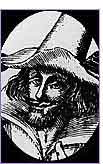The short answer is this: Guy (alias Guido) Fawkes was one of the members of The Gunpowder Plot of 1605 in which a group of Catholics attempted to blow up the Houses of Parliament and kill James I, the King of England, to protest Protestant rule. As the man chosen to light the fuse and the first captured, Guy has recieved the lion's share of attention among the conspirators. The long of it is as follows:
Since Henry the VIII's reign, England was divided between Catholics and Protestants with the factions fighting bitterly over control of the throne. Queen Elizabeth I had been staunchly Protestant, but with her death and the succession of James I as King, Catholics had thought their persecution was at and end. They were wrong. Shortly after James' coronation in 1603, it became clear he had no intention of granting leniency to the Catholics.
Guy himself was born in England in 1570 but by the turn of the century, Guy had spent several years fighting for Spain in the Netherlands, as well as participating in the Siege of Calais. His years of service earned him a reputation for his bravery and skill, especially with munitions. (Spain, a long-time rival of England, was staunchly Catholic and was often seen as an ally to English Catholics.) It was through his reputation and his pro-Catholic activities that he was brought to the attention of Thomas Wintour. It was Wintour who invited Fawkes into the circle of men that initially comprised The Gunpowder Plot.
The initial five members of The Gunpower Plot (of which Guy was one of; the Plot would eventually grow to thirteen members) first met in 1604 and began their plans. By March, 1605, the conspirators had rented a cellar under Parliament and began stockpiling 36 barrels of gunpowder. Guy was in charge of maintaining the stockpile, keeping the gunpowder fresh until Parliament's next session. In October, word of the conspiracy leaked, possibly by someone within the Conspiracy, although the warning did not mention the Plot specifically.
Believing they still had time, Fawkes and his conspirators went ahead with their plans. Parliament was due to meet on November 5th and it was that day that King James' men discovered the stockpile. They also discovered Fawkes, who was standing guard, and on his person they found all the tools necessary to light the gunpowder. Guy was captured, interrogated, and tortured; after two days he confessed the details of the Plot. Along with the surviving members of the conspiracy (several members died during attempts to capture them), Fawkes was tried on January 27th, 1606, and executed on Janury 30th.
After The Gunpowder Plot was foiled, King James decreed that on the anniversary of the plot's failure should always be remembered. 400 years later, that celebration is known as Bonfire Night where bonfires and fireworks are lit, and effigies of Fawkes (known, appropriately, as "guys") are burned, in celebration. (You'll have to ask the individual revelers whether or they are celebrating the Plot's failure or its attempt.)
It is in this context that we come to V for Vendetta. As Alan Moore wrote in his behind-the-scenes article "Behind the Painted Smile":



